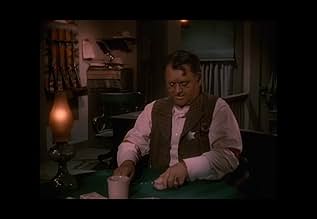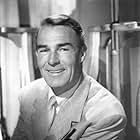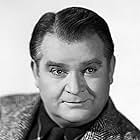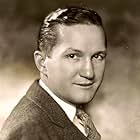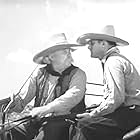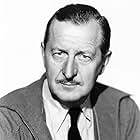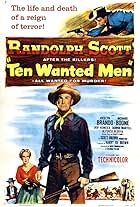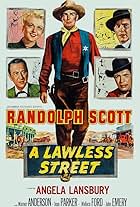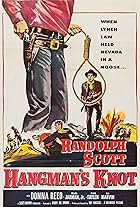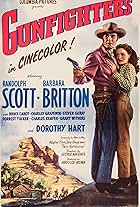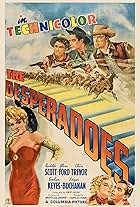IMDb RATING
6.3/10
1.3K
YOUR RATING
A mysterious stranger crosses paths with an outlaw bank robber and a greedy rancher.A mysterious stranger crosses paths with an outlaw bank robber and a greedy rancher.A mysterious stranger crosses paths with an outlaw bank robber and a greedy rancher.
Jock Mahoney
- Sandy
- (as Jock O'Mahoney)
Victor Adamson
- Barfly
- (uncredited)
Stanley Andrews
- Deputy Morgan
- (uncredited)
Stanley Blystone
- Red Sand Bank Clerk
- (uncredited)
Jack Evans
- Barfly
- (uncredited)
Nacho Galindo
- Mexican Stagecoach Driver
- (uncredited)
Charles Halton
- Red Sand Bank Manager
- (uncredited)
Storyline
Did you know
- TriviaBesides having a small role in the film, Jock Mahoney also served as Randolph Scott's double in the fight scene.
- GoofsDuring the fight scene in the mine over the gold a partial collapse of the wooden structure supporting the roof is caused by Scott crashing into a column. Pieces of the collapsed beams can be seen swinging around from the mine ceiling on silver grip chain used to 'safety' and control the special effect collapse instead of falling to the ground.
- Crazy creditsMost of the below-the-line personnel are billed at the end, rather than in the opening credits.
- ConnectionsReferenced in Svengoolie: Dr. Cyclops (2011)
Featured review
Unexceptional Westerns like this one almost always followed certain well-worn conventions. A few clips on the jaw and a man was unconscious. Men wore nondescript generic Western clothing, usually including a vest. The capo may have a string tie, possibly a suit, but most of the men wore neckerchiefs which were never used, as well as guns, which were. The girl friend was pure, although maybe mixed up. There was little in the way of character development and motivations were usually simple, as Galt's is here -- "gold fever", someone calls it. They were usually shot at a studio ranch or at Lone Pine or, as in this case, in both.
Later in the 1950s ambitious directors like Anthony Mann introduced some life into the increasingly tired comic-book stories by giving us heroes who were neurotic and subsidiary characters with complicated motives. Other directors simply gave up trying and turned the cartoon into a parody, like one of those Steig cartoons in which a hand is seen drawing itself. Budd Boetticher was a director who gave up and reveled in the primitivism of the form.
That's when Randolph Scott made the Westerns he's best known for, like "Ride Lonesome." Great title there. Scott's character was reduced to a prig, as morally upright as a gastropod on its poduncle, always putting temptation behind him, never telling a lie, rejecting offers of warmth and comfort from women -- a total bore, in other words.
"The Nevadan" had the same producers as the later Boetticher films but Scott's character hadn't quite hardened into the inflexible clunk yet. He smiles here. He fibs too. He only shoots one guy, and not by outdrawing him either. It's an improvement over his later persona. But the villains aren't. Boetticher's villains were great -- Lee Marvin, Richard Boone, Pernell Roberts, James Coburn. The heavies here are not nearly as much fun. How can anyone take George MacReady seriously as a Western head heavy? He belongs in a corporation as part of a conspiracy. Faylen still sounds like the taxi driver in "Dark Passage." Ray Corey is supposed to have been a well-regarded drama teacher later on, and he gave a flawless performance in "In Cold Blood," but he brings nothing to the party here as a dull-witted joke. But the woman, Dorothy Malone, has never looked better, fresh faced, young, and innocent, as MacReady's daughter. Hollywood had a habit of glamorizing her to the point of unrecognizability. They gave her glossy hairdos, slick lips, two tons of pancake or waffle makeup, and false eyelashes the size of those canvas tarps you put up as extensions of your mobile home. She's a surprise. Nobody else in this movie is.
But it's also worth mentioning Jock Mahoney as "Sandy," one of the bad guys. He was as homely as they come, but the man's physical presence was magnetic. I'm sure he didn't deliberately try for the effect but every swift movement was as graceful as a dancer's, the opposite of John Wayne who seemed to move by putting one or two limbs in motion and letting his torso follow them sometime later on. One example: watch the scene in which Malone gives Mahoney's horse a kick in the hindquarters and Mahoney finds himself splashing down into a creek, then spins the horse around and climbs the bank as if man and animal were one being, just as the Aztecs thought.
Later in the 1950s ambitious directors like Anthony Mann introduced some life into the increasingly tired comic-book stories by giving us heroes who were neurotic and subsidiary characters with complicated motives. Other directors simply gave up trying and turned the cartoon into a parody, like one of those Steig cartoons in which a hand is seen drawing itself. Budd Boetticher was a director who gave up and reveled in the primitivism of the form.
That's when Randolph Scott made the Westerns he's best known for, like "Ride Lonesome." Great title there. Scott's character was reduced to a prig, as morally upright as a gastropod on its poduncle, always putting temptation behind him, never telling a lie, rejecting offers of warmth and comfort from women -- a total bore, in other words.
"The Nevadan" had the same producers as the later Boetticher films but Scott's character hadn't quite hardened into the inflexible clunk yet. He smiles here. He fibs too. He only shoots one guy, and not by outdrawing him either. It's an improvement over his later persona. But the villains aren't. Boetticher's villains were great -- Lee Marvin, Richard Boone, Pernell Roberts, James Coburn. The heavies here are not nearly as much fun. How can anyone take George MacReady seriously as a Western head heavy? He belongs in a corporation as part of a conspiracy. Faylen still sounds like the taxi driver in "Dark Passage." Ray Corey is supposed to have been a well-regarded drama teacher later on, and he gave a flawless performance in "In Cold Blood," but he brings nothing to the party here as a dull-witted joke. But the woman, Dorothy Malone, has never looked better, fresh faced, young, and innocent, as MacReady's daughter. Hollywood had a habit of glamorizing her to the point of unrecognizability. They gave her glossy hairdos, slick lips, two tons of pancake or waffle makeup, and false eyelashes the size of those canvas tarps you put up as extensions of your mobile home. She's a surprise. Nobody else in this movie is.
But it's also worth mentioning Jock Mahoney as "Sandy," one of the bad guys. He was as homely as they come, but the man's physical presence was magnetic. I'm sure he didn't deliberately try for the effect but every swift movement was as graceful as a dancer's, the opposite of John Wayne who seemed to move by putting one or two limbs in motion and letting his torso follow them sometime later on. One example: watch the scene in which Malone gives Mahoney's horse a kick in the hindquarters and Mahoney finds himself splashing down into a creek, then spins the horse around and climbs the bank as if man and animal were one being, just as the Aztecs thought.
- rmax304823
- Jan 5, 2004
- Permalink
- How long is The Nevadan?Powered by Alexa
Details
- Runtime1 hour 21 minutes
- Aspect ratio
- 1.37 : 1
Contribute to this page
Suggest an edit or add missing content







